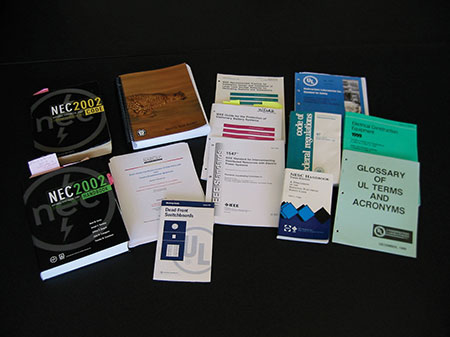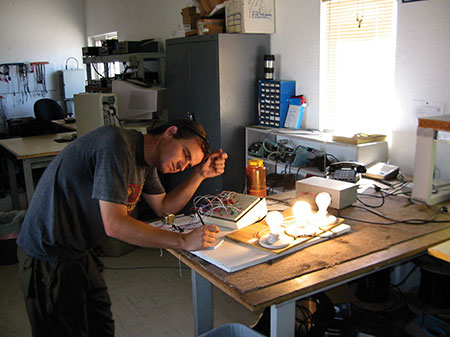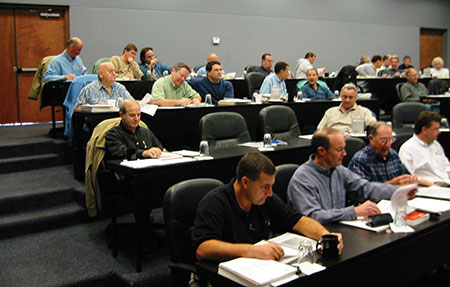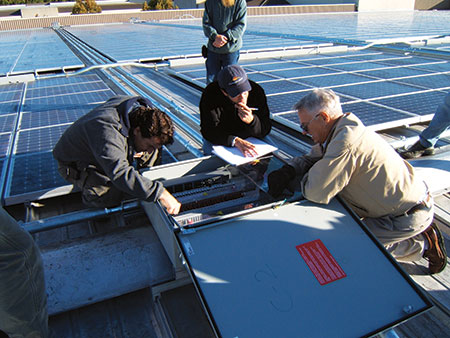The technologies of high-speed computers, microprocessors and integrated circuits are causing a continual evolution and even a revolution in many devices that are installed in dwellings and commercial buildings. The smart grid is leading to smart appliances. The Internet of Things (IoT) is a term used to indicate that numerous small electronic and some non-electronic devices throughout the building may be interconnected to the network inside the building and to the larger World Wide Web outside the building.
These new devices may include ranges, washers and dryers, refrigerators, HVAC systems, security systems, electric vehicle charging stations, lighting systems, ventilation systems, window shading systems, and even exercise equipment. Even the relatively simple plumbing systems will have touch-operated faucets and controls, on demand and occupancy sensor controlled recirculation systems, integrated solar hot water systems, and leak-detecting water shutoff controls.
While some of these devices may operate wirelessly, others will be hardwired and many will require power circuits connected to control devices that have not been commonly used in residential and commercial applications. These new power circuits, and possibly the structured wiring systems associated with the communication circuits, will come under requirements added to the National Electrical Code (NEC). New equipment designs (possibly going back to that early futurist Tom Edison) and ongoing changes to the NEC indicate that we will see more direct current (DC) circuits in dwellings and commercial buildings to power lighting systems, electronic devices and possibly appliances. The LED (light emitting diode) lighting systems (the basic LED operates at about 3 V DC) and appliances with electronically commutated motors (ECM) with solid-state controllers can be more efficient when operated on direct current rather than 120 V AC.
It isn’t your Father’s Electrical System” and the AHJ Must Keep Up
For more than a century, electrical power systems have used conductors, disconnects, overcurrent devices, sources, and loads. The typical electrical inspector has generally been more familiar with these subjects and more knowledgeable on the related components and equipment than the electrician doing the electrical installation. However, that situation is rapidly changing. The codes alone no longer provide sufficient information to ensure that the electrical installations are made properly because devices based on the newer technologies and their installation requirements, in many cases, are too complex to put the installation details into the Code. More and more electrical installations will be made under NEC Section 110.3(B) where the installation instructions provided with the listed equipment must be followed (and subsequently inspected) to ensure a safe and code-compliant installation.
These rapidly changing new technologies and the constantly changing codes will dictate that inspectors in all disciplines, electrical, mechanical, and plumbing, must continually study these new technologies and the changes in the code to ensure the safety of the public. Although these technologies will impact all inspectors in all disciplines, this article will focus on the Electrical Specialist AHJ and on any inspector who must inspect electrical systems.
Electrical Inspectors arrive in that position through many different paths. Some come up through the electrical trades and are master electricians before they move into the electrical inspection field. Others have been known to have college degrees in electrical engineering or in other fields and for personal reasons elect to pursue the electrical inspection career path, which has a very direct impact on the safety of the people living with and using those electrical systems. Due to budget constraints that affect many communities, as well as all of us, many new Electrical Inspectors are actually Combination Inspectors who, in previous jobs, were possibly HVAC or Plumbing Inspectors and who are cross training into the electrical field. Many jurisdictions are hiring only Combination Inspectors that will be doing plumbing inspections one day, mechanical inspections the next day, and electrical inspections the third day.
It behooves any inspector, no matter what their professional field or background, to keep abreast of the changes in technology and the changes in the code for their inspection field. The next few paragraphs cover some of the methods and sources for that education and training starting with the Combination Inspector who is new to the electrical field and leading to the Electrical Specialist Inspector who may be required to inspect complex, utility-sized photovoltaic (PV) systems on a daily basis.

SOURCES OF MATERIAL
The Basics
Inspectors are people of all ages who lead busy lives and have little time to engage in training and education unless, of course, it’s required as part of the job and is available during normal work hours. The older generation, like myself, seems to prefer textbooks and reading materials that can be viewed at leisure (photo 1). The younger generation seems to be more oriented towards short snappy presentations that can be viewed on their smart phones (or so the advertising would have us believe). And those middle-aged among us are somewhere in between. Classroom presentations, seminars, and workshops seem to work for many people and that is how our education system has been for many years. I strongly feel that anyone engaged in the inspection of electrical systems, must have a basic understanding of electricity and electrical fundamentals. This would include knowledge of volts, amps, watts, watt-hours, resistance, capacitance and inductance and transformers (photo 2). The difference between alternating-current circuits and direct-current circuits and how the equipment connected to them impacts them is also a basic knowledge requirement. Electronics and how they exercise control of power systems is going to be more important as we move into the smart grid/smart home/smart appliance era.

Many community colleges provide adult education classes—at night and on weekends—that cover basic electrical fundamentals and in some cases are aimed at training electricians and Electrical Inspectors. Any Combination Inspector or other inspector entering the electrical inspection arena without the basics should consider looking for courses taught by these institutions. Also, a basic course on physics will include some of these electrical fundamentals and many colleges teach Electrical Engineering 101, which might be appropriate for an introduction to electrical fundamentals. Such courses may be audited in some schools at no cost, but without credit (photo 3).

Basic math skills will be necessary and they will include addition, subtraction, multiplication and division. The ability to find an unknown quantity in a relationship where there may be three or more known quantities is a skill that will be useful. An inexpensive solar-powered pocket calculator will be used in the office and in the field as well as during any educational exercise. Smart phones will have that calculator.
No spare time to attend class? Then, the textbook for the class might be purchased for home study. A search on Amazon.com for “Basic Electricity” will yield dozens of text books and home study courses on this subject including some texts published by the Navy for their training programs. All of IAEI books are offered on Amazon and at www.iaei.org.
After the Basics, on to the Code
Any inspector or inspector-trainee needs to be familiar with the Code fundamentals and that means starting with and understanding Chapter 1 of the NEC. The administrative requirements of any local jurisdiction or state codes should be reviewed at this time.
Most new inspectors receive on-the-job training and this is certainly valuable when the trainer is a seasoned Electrical Specialist Inspector and when numerous electrical systems are jointly inspected in some detail (photo 4).
Training to be a Plan Reviewer is different since the trainee is at a desk with a Plan Reviewer working through the various diagrams and schematics provided and checking and rechecking all of the basic assumptions and calculations that were included in a plan submittal.
After the actual National Electrical Code and the National Electrical Code Handbook [both published by the National Fire Protection Association (NFPA) (www.nfpa.org)], one of the best sources of basic information on the Code is International Association of Electrical Inspectors (IAEI) (www.iaei.org) and their numerous publications, one of which you are now reading.
In fact, one of the better discussions of the NEC requirements as applied to residential and commercial electrical installations is the well-illustrated series of articles written by Randy Hunter that appears in IAEI magazine (www.iaeimagazine.org). A current subscription and the IAEI Archives (on their web site) will get all of these continuing articles. Then there is the IAEI catalog of products that include numerous books on many different sections of the Code written by experts in the various fields. Many of those writers are actually involved in developing the NEC. The Soares Book on Grounding is one of my favorites.
Again, a web search will reveal numerous books, courses, seminars, and presentations on Code basics that can be used not only by the new Combination Inspector, but also by the seasoned Electrical Specialist Inspector to keep up with the new technologies and in many cases to meet continuing education requirements.

Advanced, Detailed Information will be required
As technology advances, and it will, the AHJ must keep up. I think the standard practice of the electronics industry is: “We have a micro processor that will fit in that device (phone, thermostat, broom, receptacle outlet, car, light bulb, etc.), let’s see how many functions we can squeeze in there.”
Continuing education is a must for all inspectors. Although the basics of the code and electrical power systems can be mastered, the code and those systems are continually changing. Many jurisdictions require continuing education in order to keep the inspector fully informed on the latest developments in the electrical power industry and in the code requirements addressing those developments.
Again, IAEI is a good place to start looking for that advanced information in their publications and in IAEI magazine which addresses the latest developments in the various sections of the code and the electrical systems that that code covers. Also, IAEI has an e-mail newsletter service that will alert the subscribers to articles and bulletins on the very latest technologies that may eventually affect the Code.
Underwriters Laboratories (UL) offers advanced courses on many subjects related to electrical systems. UL also publishes the White Book that gives invaluable information on all categories of listed equipment restrictions and on how that equipment may be used. Google “UL White Book” for a free copy of the latest edition. At over 1000 pages, it is an almost mandatory resource to supplement the NEC and includes numerous useful documents including the UL Marking and Application Guides as well as a cross reference between NEC sections and UL listing categories
The manufacturers of nearly all electrical equipment types, including the most complex, offer web-based video training programs on their equipment and numerous detailed installation instructions for that equipment in the form of catalogs and tech manuals. It behooves the inspector inspecting electrical systems using these types of advanced equipment to be familiar with the correct installation requirements for such equipment. And each piece of equipment will have different instructions. For example, a DC lighting system integrated into a dropped ceiling cannot be connected from the feeder conduit located above with a Type AC cable pigtail, because such cable is usually not listed for direct current.
Photovoltaic (PV) Installations
Inspectors should know that some of the larger PV systems integrators and installation companies spend as much as four hours per week training their people on the basics of the Code, the changes in the PV equipment, how that new equipment is to be integrated into the system designs, what the Code does or does not address, and how the equipment is to be installed.
New equipment abounds in the PV industry. Some is driven by Code requirements but some leads the Code revisions and much of it will be more complex, in terms of installation requirements than the Code will be able to address.
A recent example is the DC-to-DC converter that may be connected to each module, may be only connected to some modules, or may be installed inside the back-of-module junction box. The DC-to-DC converter decouples the module output (volts and amps) from the rest of the modules in the source circuit or in the rest of the system. The normal conductor and overcurrent device calculations for the module by itself as required by NEC Sections 690.8 and 690.9 no longer apply to the output of these converters. To further complicate the installation, these DC-to-DC converters may communicate with the connected inverter and the inverter may further modify and restrict the output of the converter under normal and abnormal operating conditions. Since each manufacturer of these devices has its own design, there is no commonality between them. It is not possible for the NEC to incorporate installation requirements for such a diverse group of products.
In this and with other types of PV equipment, Section 110.3(B) of the Code must be used and the instructions in the installation manual must be followed and verified to ensure that the product and its installation meet minimum Code requirements. As mentioned in previous articles in this series, all inspectors and all jurisdictions should be requiring copies of all equipment instruction manuals to be submitted with the permit application. Both the Plan Reviewer and the Electrical Inspector should review the instruction manual requirements against the provided diagrams and the field installation to ensure compliance.
Here is a common error that results from not reading the installation manual. A 2500-watt PV inverter is being installed. The rated continuous output current at 240 volts is 10.4 amps. The NEC, in 690.8, would require the 125% multiplier on this current giving a maximum current of 13 amps. A 14-AWG cable and a 15-amp overcurrent device, typically a circuit breaker, would meet Code requirements to make the connection from the inverter to the main service panel. However, the PV installer/electrician has some 12-gauge wire in the truck and only a 20-amp circuit breaker and elects to use these since they appear to meet the code for this 13-amp circuit. However, the installer has not read the instruction manual for this listed inverter and that instruction manual has a requirement limiting the overcurrent device to 15 A. This external overcurrent device is used to protect internal inverter components that otherwise would have required an internal overcurrent protection device unnecessarily increasing the cost of the product and increasing maintenance difficulties.
PV Education and Training
Plan Reviewers and Inspectors can again look at the IAEI website and consider purchasing the author’s books on Photovoltaic Power Systems and the National Electrical Code for Inspectors and Plan Reviewers [first and second editions are available (www.iaei.org)]. Also, this series of articles, “Perspectives on PV,” in the IAEI magazine may be reviewed and back issues obtained from the archives on the IAEI website. From time to time, other articles on PV will appear in the magazine. There are community colleges and other sources of classroom training and online training available throughout the country, and a web search will reveal numerous sites. UL has a certification program for electricians who want to be certified as PV installers: http://lms.ulknowledgeservices.com/catalog/display.resource.aspx?resourceid=285443. For advanced training on specific pieces of equipment, most of the manufacturers of that equipment offer web-based training courses and seminars on their equipment.
Inspectors and Plan Reviewers who are intent on learning all they can about photovoltaic power systems might consider visiting the website of the North American Board of Certified Energy Practitioners (NABCEP) (www.nabcep.org) where information can be a obtained including a list of study references for PV installers pursuing certification at entry and advanced levels. NABCEP is considering developing a certificate for Electrical Inspectors who have demonstrated above average knowledge and understanding in skills of inspecting PV systems.
Summary
Technology advancements are increasing at a rapid pace. Continuing education must become an inherent part of the job responsibilities of the Plan Reviewer and the Electrical Inspector. Every jurisdiction should plan and program for continuing education of their personnel. Only by aggressively pursuing these actions and activities can the inspector community maintain the respect and trust of the general public that has been hard-earned and well-deserved over many decades.
For More Information
The author has retired from the Southwest Technology Development Institute at New Mexico State University, but is devoting about 25% of his time to PV activities in order to keep involved in writing these “Perspectives on PV’ articles in IAEI magazine and to stay active in the NEC and UL Standards development process. Seven to eight hour presentations are still available on PV and the Code and they cover 2008–2014 NEC requirements. He can be reached at: e-mail: jwiles@nmsu.edu, phone: 575-646-6105
The Southwest Technology Development Institute web site maintains a PV Systems Inspector/Installer Checklist and all copies of the previous “Perspectives on PV” articles for easy downloading. A color copy of the latest version (1.93) of the 150-page, Photovoltaic Power Systems and the 2005 National Electrical Code: Suggested Practices, written by the author, may be downloaded from this web site: http://www.nmsu.edu/~tdi/Photovoltaics/Codes-Stds/Codes-Stds.html.










Find Us on Socials